Jay Fisher - Fine Custom Knives
New to the website? Start Here
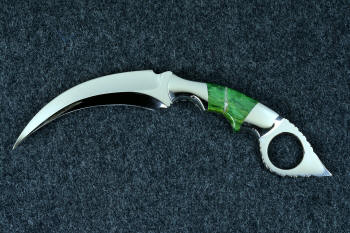
"Raptor"
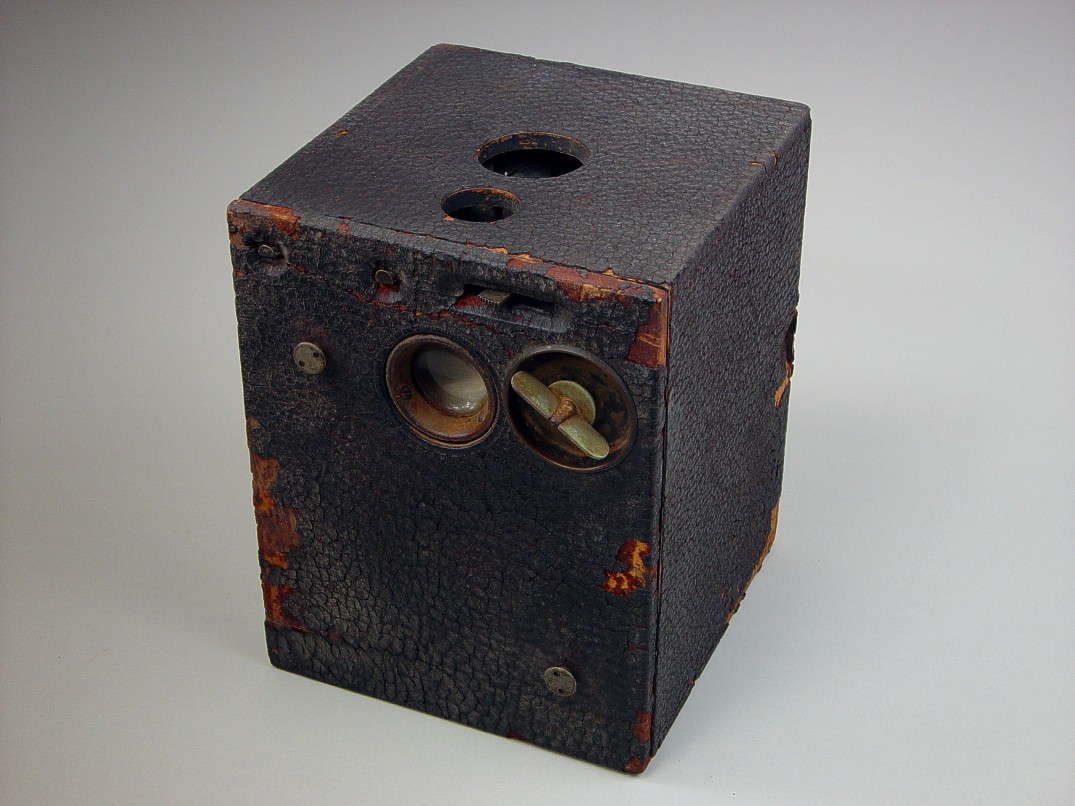
It's hard to describe how much photography has meant to me in my life. The first photos I took were with a twin lens reflex 120mm film camera borrowed from my parents in the late 1960s. I bought my first 35mm single lens reflex film camera while in high school, and carried it around faithfully for decades, creating thousands of transparencies (slides). I knew photography would play a role in my life, but didn't understand just how critical it was.
I photographed when I was travelling, when I was practicing archaeology, when I was hiking, camping, and spending time with family. When knives started popping into my life, I carried on an arduous campaign to create worthwhile photos of them. Since I could not get the development and print reproduction I sought from commercial sources, in the mid-1980s, I build my own darkroom. This grew into working with a multitude of processes and formats, I worked with just about every chemical process available and every media I could. I taught photography, photographed ghost towns, public events, rodeos, the military, celebrities, and printed, matted, mounted, and built custom frames for some of my work. I used darkroom manipulation, conversion techniques, and even integrated photochemical milling with some of my art projects and for professional testing and demonstration for a large radiotelescope.
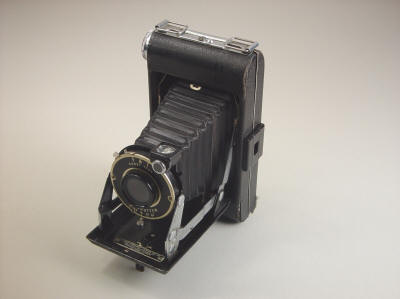
This old folding camera has a fixed focus, but has an adjustable
aperture: from f/12.5 to f/32, so it had some workability.
It has a Kodet lens and a DAK shutter, using type 620 film. The nameplate has "SIX-20" on it, as if that was some special designation.
You could outfit it with a cable release for those long exposures. One might wonder about fogging the film, as the tiny
stamped aluminum window to indicate the frame number on the back covering the orange plastic instructs: "Open only while winding."
Build in 1940 to 1949, this particular camera might have even photographed the relative who was going off to fight
the big one, and that was worth the $8.50 it cost to purchase back then.
Early advertising claimed: "Newest star among inexpensive folding
cameras. Single push button for opening and closing. Both eye-level
and waist-level finders. Extra-rigid lens support. Kodet lens
... requires no focusing. New Dak shutter, with time, "bulb," and
snapshot settings. Black morocco-grain covering. Pictures, 2¼ x 3¼
inches."
The price of this camera back then would be about $150.00 in today's money. A fair
price to pay for those memories and images.
I used a variety of cameras and formats. My favorites were 35mm, 120 (6 x 6 cm) and 4 x 5". I studied in black and white and color processes, including transparences, color reversal prints, negatives, and lithographs. I worked in high resolution films, infrared, and high speed. I learned about filters, darkroom techniques of doging and burning, masking and manipulation. I used selective toning processes, granulation, and photo montage.
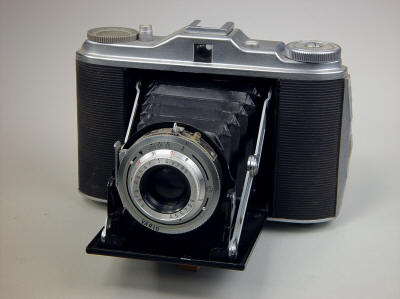
This is a medium format folding camera, c 1950, with film type 120 (6 x 6 cm). This is a tight little camera with a sizeable format, and feels solid and tough. Shutter speeds range from bulb to 1/200th of a second, with an iris of f/4.5 to f/32. Ring focusing down to 3.5 feet would probably give some pretty good close ups, and it has a handy little depth of field calculator opposite the winding knob. This one has an Agfa Agnar lens, not the best they made for this camera, but serviceable.
This camera is so tight and compact that I can easily see how it was a precursor to the 35mm single lens reflex to come.
When family and friends find out you're a photographer, and are dedicated enough to have your own darkroom,
they discover a place to bring their old cameras. Few old cameras are worth much, but I still use the first
Rolliflex camera that was given to me with the "loan or repair" caveat. In case you're unfamiliar with this,
here is how it goes:
"If it's easy to repair, I want it back. If you have to spend any serious money or time repairing it,
you can keep it."
Back in the early tube television days, my father accepted the same type of warning rules with televisions that he frequently repaired. Like cameras, it's always costly in time to repair them, and sometimes expensive in parts. The previous owner is always surprised when, after having invested many hours into the work, he finds that the guy doing the repairs is justified in keeping what was simply a discarded piece of technology. If he suggests returning the now functioning item, and you hand him a bill for several hundred in labor, he's miffed about it. Most people assume labor is a gift in these transactions.
The Rollei was the first major camera rebuild I attempted, and it was a great success. When I got it, there were pieces rolling around inside the body; evidently it had been carried around in the trunk of a car for decades, shaking loose every screw inside. What a mess! After I completely rebuilt it, I used it to create some of the finest photos I've made.
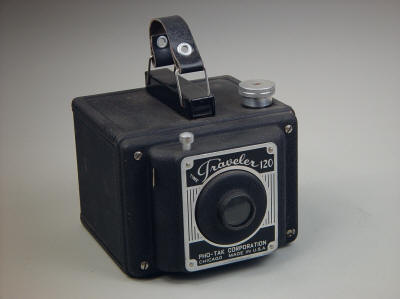
This is one of the simplest, sturdiest cameras I've seen. The body is stamped sheet steel with a textured coating that will barely take a scratch. One shutter speed, a sliding tab for bulb setting (you've got to hold the shutter open very still, because there is no tripod mount), and no aperture adjustment with a single tiny lens makes this about the closest thing to a pinhole camera made. It doesn't even have any mechanism to hold the case to the front, just a few detents and luck and the spool winder. This model was made in the 1950s and is a 6 x 9 format.
I can imagine that this would be a great intro camera for the studious Boy Scout to get his photography merit badge taking pictures of the family pets, sunsets, and birds too far off for any detail. He could drop the camera down a ravine and do no harm...
After a while, these old cameras find you, even if you try to avoid them. I guess they're looking for a good home, to be understood, to be respected for their place in history. They're not worth much, some were common and cheap, some were unusual and unwieldy, but they occupy a special place in my heart. Maybe one day, I'll custom cut some film for them and make them all active again, bringing them into the new millennium. Until then, I'll enjoy showing them to the grandkids.
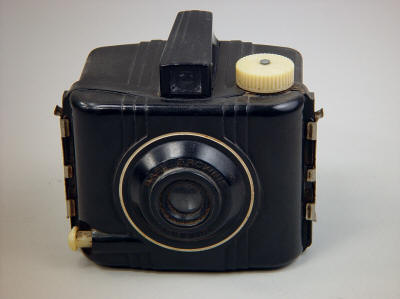
Made c. 1940, this is an all Bakelite camera body. Bakelite is an early form of phenolic thermoset plastic, the ancestor of modern Micarta that I use on knife handles. Bakelite is a bit brittle, and has a characteristic smell when you rub it. Some people collect anything made of Bakelite.
This Baby Brownie is very small, fits in the palm of the hand, with even less controls and features than the PHO-TAK above. One simple shutter release and that's it. It uses type 127 film, in a 4 x 6 cm format.
This type of camera is called a box camera, and quick tourist photography was its purpose and market. There are still some foreign firms making film for this type of camera today.
Most of the photos and all of the new photos are, of course, digitally produced. I still get in the darkroom now and then to create some retro photography, but since the medium you are looking at is digital, the digital medium is a best fit for the knives.
Most photographers didn't want to see the digital revolution come; we were happy that it took such difficult processes and study to produce viable photographic records, and we didn't want to give up all we had invested in the art and trade. But like most technological advances, the result was an easier process, and if you wanted to hold onto your old chemical process with a death grip, you still could. After all these digital years, I'm still not willing to let go...
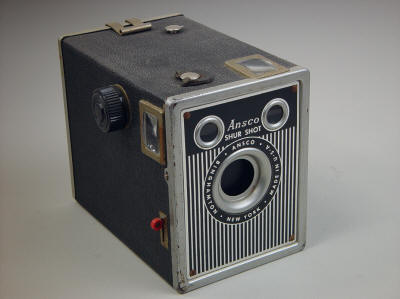
This camera has a sheet steel front and back, with a compressed cardboard body and was built c. 1938. There are no adjustments on the camera, just a simple shutter that opens when you press the red knob, and resets when the red knob is lifted. The lens is inside of the shutter, which is unusual, as the shutter is not protected from dirt or exposures. It's got a neat pair of viewfinder windows, one for landscape and one for portrait orientation. Uses 620 film, in a 6 x 9 exposure size.
Here are a few more of the old ghosties. Maybe I'll add to this page as time permits. Though I don't collect knives, I evidently do have a collection... collecting mostly dust. Please enjoy the photos, and think of when they were once used, and what personal and important images they once created for the families that loved them.

Built around 1955, this Brownie has some very nice potential. The body is Bakelite, and the outfit includes some eyeball-frying flash bulbs for those dark and private family moments. The flash holder is midget sized, Bakelite also, with a thin pressed aluminum back that has a handy film type and flash guide chart. The camera is quite an improvement from the little Brownie above, with a heavy and solid body, Twindar lens, "long" or "instant" shutter openings, a variable focusing lens with a detent stop at 10 feet (just right for the eye-burning flash) and a very simple quarter-turn latch to open the back and load film. The film advance knob sets the shutter, so double exposures are avoided. It uses a 620 film in a 6 x 9 format. It's always nice to include the sturdy cardboard case with a good supply of blue dot Sylvania flash bulbs.
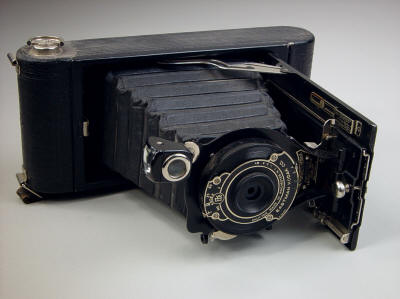
You'd have to have a strong pocket to carry this beast around, but it folds up nicely. The body is all sheet steel, so it's pretty sturdy and the Old English nameplate reminds me of something from a gang tattoo. It uses type 116 film, and this camera was made from 1926-1932. The entire back has to come off to load the film, which was pretty big at 2½×4¼ inch negatives (6.5×11 cm). The camera has an adjustment for range, a little knob turned on the beam moves the lens plane in and out, corresponding with a distance scale. The shutter has Time, Bulb, 1/25th, and 1/50th of a second settings, and the lens is inside the shutter. It's got a neat little sliding window on the back so you can see if you've come to the end of the film roll. Not wise to open, unless you want to fog the film. Remember that this camera was created during the depression, and was probably quite an investment for anyone who could afford one.
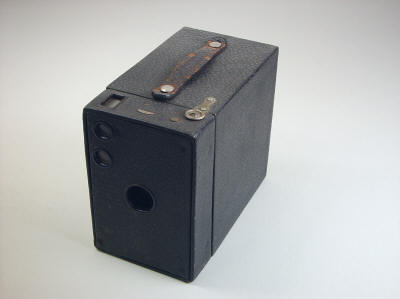
This No. 2a Brownie box camera is an early model because it has a cardboard body covered in leatherette. The shutter on this camera works in either direction, and the lens is inside the box, behind the shutter. It was probably built around 1920, and has two viewfinders depending on the orientation of he operator. The film was type 116, (6.5 x 11), and the back is held on by two small keyhole straps and the film winder knob. The winder knob rivets were the first thing to fail, as the cardboard body would wear as you pulled out the winder. This is probably why later models went to the metal body construction. It's interesting to note that you are looking at one of the most prolific cameras ever created, mass produced by the millions.
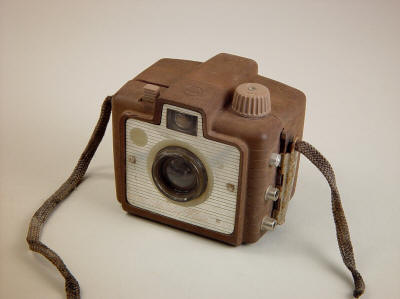
Alas, the holidays are long gone for this heavily weathered Brownie. It's missing its flash unit also, though if I needed one, the Brownie Bull's-eye midget flash should plug right in. This camera was made in the mid-1950s, and was originally a dark black-brown and glossy, but this is what happens to Bakelite when it's left out in the sun and rain for years. The red is bleached completely out of the aluminum face plate and rust has made its way into the mechanism. I suppose it could be scavenged for parts. This type of camera frequently had cracks, as the Bakelite is brittle. The Brownie used a type 127 film, and was a lightweight, handy camera for those quick holiday shots.
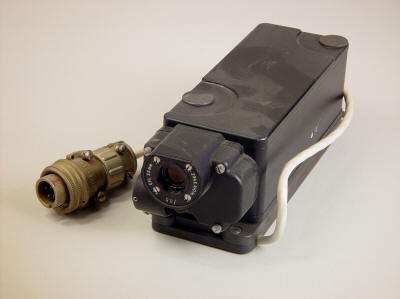
No doubt used aboard Viet Nam era aircraft to record gun site strikes or reconnaissance in F8 Crusader or an F11 Tiger fighters, this a 16mm motion picture camera. Kodak makes this kind of camera also. This one was probably made in the mid-1950s, and the camera has a dedicated mounting plate so the camera could be removed and taken to a darkroom to pull the film reel. The camera has a built in lens heater, camera body heater, and thermostat to control them. It has a manually adjustable aperture, so the camera man had to know whether he needed f/3.5, f/5.6, f/8, or f/16 to expose the strike. I wonder what this one has recorded, and where those thousands of reels of film are stored.
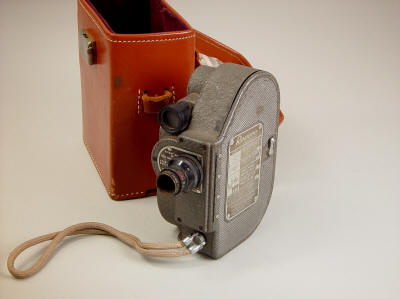
Produced in 1940, this 8 mm motion picture camera has a Wollensak Cine Raptor 13mm, f/1.9 lens, and quite a few adjustments, charts, and dials to get the aperture adjusted right. This lens is pretty fast for the little camera, the fastest they offered at the time for the Revere. The camera is wound with a key to load a spring, and operated with a simple button. The film was double, which meant that the 25 foot roll was exposed during filming, turned over, and then run through again. The film was then slit in half at the processor, who spliced it to a 50 foot length after processing. There are still companies making film for this type of camera today, though rare. The mechanical operation of this camera is incredibly quiet and smooth.
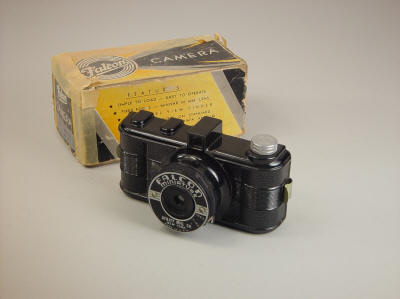
With a 50 mm lens and very simple operation, this Bakelite camera was offered in 1939. My model claims it's easy to load, fixed focus, takes Kodak 127 or Agfa A8 film, and has a beautiful ebony black plastic case. The camera has two red plastic windows on the back and you had to coordinate these with the film paper print to orient the film in the camera for the next shot. This was, no doubt, one of the cheapest and easiest to use cameras made. This one evidently did not get much appreciation as the 70 year old cardboard box is still with it, including the antique masking tape. The owner really knew how to treat a fine instrument!
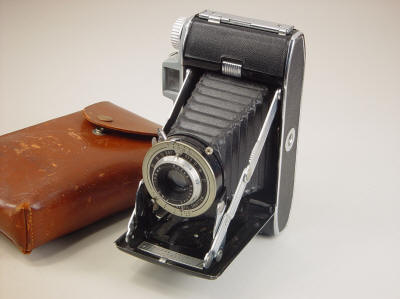
Made from 1948-1951, the tourist used 620 film and produced quite a good sized photo for contact printing or enlarging. This one has a 105 mm f/6.3 Kodak Anaston lens, time, bulb, 1/25, 1/50th, 1/100 second shutter speeds and an aperture that adjusts from f/6.3 to f/22. The lens has a handy depth of field calculator on the frontspiece, and can accommodate a flash unit (no doubt sold separately). It also has a handy exposure calculator on the back, as the typical tourist was not expected to carry a light meter. This particular model was actually top of the Tourist chain back then, costing the equivalent of about $1000.00 at today's prices. It could produce professional results.
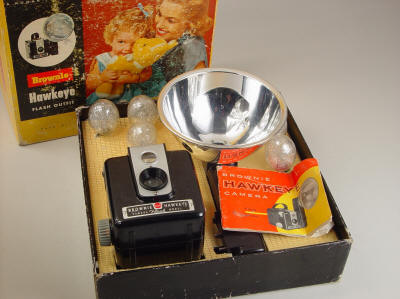
The camera gets little mention; it's all about the flash on this old Brownie. Made from 1950-1961, families could easily see the results of their photos on the box front. I'll add that their hair was probably singed, the teddy bear scorched, and the child temporarily blinded by the hefty scorching monster flash bulbs and huge polished reflector that the "Outfit" supplied. All Bakelite including the flash case, The most interesting thing that came with this one was a processing price list from a company in West Durham, North Carolina that would develop your film for 90 cents a roll.
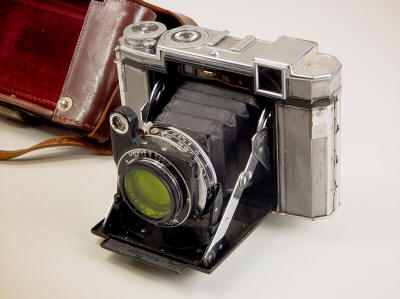
This is actually a very fine camera, sought out for its high photographic reproduction and quality even today. It's a heavy camera, mine has been stripped of its leatherette (which was of poor quality as on most of this type of camera) and needs a recovering and a new bellows. I spent some considerable time repairing and rebuilding the shutter, which had a lot of gunk and one microscopic broken part. Maybe I'll cover the beast in burgundy ostrich, or lizard skin, and get a red bellows...
The camera has a coupled rangefinder, a f2.8 80mm Tessar lens with a Compur Rapid shutter, and was built in 1937.
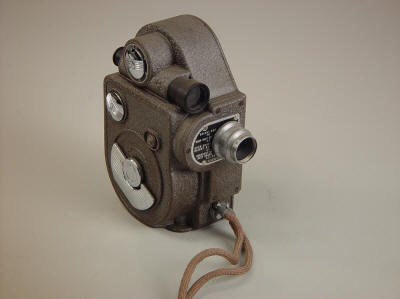
This Revere is a tight, solid, and very quietly operating camera, and would take a double 25 foot roll of 8 mm motion picture film. It has a Wollensak-Revere 13 mm f/2.5 lens, and was called the model 88, just like the Revere I listed above, but it is a different camera, with different lens. It was probably produced in the 1940s.
Just like the still cameras, there is a following of these old motion picture cameras, and some companies are still making film for them. As solidly as this one is built, I think it will be around for a long time.
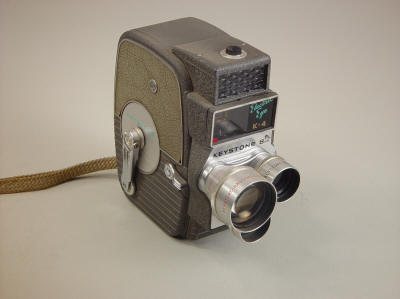
The most notable thing about this camera is the triple lens turret. This allowed some flexibility, as well as saying to your fellow motion picture enthusiasts that you were semi-professional! The camera has Bausch and Lomb lenses: 7.5 mm f/1.8 wide angle, 11.5 mm f/1.8 normal, and 2x f/1.8 telephoto. It's even got a nice built-in light meter to get the perfect exposure. This camera was made about 1960, and was said to be popular among private eyes, as it is fairly small and allowed telescopic reach.
| Main | Purchase | Tactical | Specific Types | Technical | More |
| Home Page | Where's My Knife, Jay? | Current Tactical Knives for Sale | The Awe of the Blade | Knife Patterns | My Photography |
| Website Overview | Current Knives for Sale | Tactical, Combat Knife Portal | Museum Pieces | Knife Pattern Alphabetic List | Photographic Services |
| My Mission | Current Tactical Knives for Sale | All Tactical, Combat Knives | Investment, Collector's Knives | Copyright and Knives | Photographic Images |
| The Finest Knives and You | Current Chef's Knives for Sale | Counterterrorism Knives | Daggers | Knife Anatomy | |
| Featured Knives: Page One | Pre-Order Knives in Progress | Professional, Military Commemoratives | Swords | Custom Knives | |
| Featured Knives: Page Two | USAF Pararescue Knives | Folding Knives | Modern Knifemaking Technology | My Writing | |
| Featured Knives: Page Three | My Knife Prices | USAF Pararescue "PJ- Light" | Chef's Knives | Factory vs. Handmade Knives | First Novel |
| Featured Knives: Older/Early | How To Order | 27th Air Force Special Operations | Food Safety, Kitchen, Chef's Knives | Six Distinctions of Fine Knives | Second Novel |
| Email Jay Fisher | Purchase Finished Knives | Khukris: Combat, Survival, Art | Hunting Knives | Knife Styles | Knife Book |
| Contact, Locate Jay Fisher | Order Custom Knives | Serrations | Working Knives | Jay's Internet Stats | |
| FAQs | Knife Sales Policy | Grip Styles, Hand Sizing | Khukris | The 3000th Term | Videos |
| Current, Recent Works, Events | Bank Transfers | Concealed Carry and Knives | Skeletonized Knives | Best Knife Information and Learning About Knives | |
| Client's News and Info | Custom Knife Design Fee | Military Knife Care | Serrations | Cities of the Knife | Links |
| Who Is Jay Fisher? | Delivery Times | The Best Combat Locking Sheath | Knife Sheaths | Knife Maker's Marks | |
| Testimonials, Letters and Emails | My Shipping Method | Knife Stands and Cases | How to Care for Custom Knives | Site Table of Contents | |
| Top 22 Reasons to Buy | Business of Knifemaking | Tactical Knife Sheath Accessories | Handles, Bolsters, Guards | Knife Making Instruction | |
| My Knifemaking History | Professional Knife Consultant | Loops, Plates, Straps | Knife Handles: Gemstone | Larger Monitors and Knife Photos | |
| What I Do And Don't Do | Belt Loop Extenders-UBLX, EXBLX | Gemstone Alphabetic List | New Materials | ||
| CD ROM Archive | Independent Lamp Accessory-LIMA | Knife Handles: Woods | Knife Shop/Studio, Page 1 | ||
| Publications, Publicity | Universal Main Lamp Holder-HULA | Knife Handles: Horn, Bone, Ivory | Knife Shop/Studio, Page 2 | ||
| My Curriculum Vitae | Sternum Harness | Knife Handles: Manmade Materials | |||
| Funny Letters and Emails, Pg. 1 | Blades and Steels | Sharpeners, Lanyards | Knife Embellishment | ||
| Funny Letters and Emails, Pg. 2 | Blades | Bags, Cases, Duffles, Gear | |||
| Funny Letters and Emails, Pg. 3 | Knife Blade Testing | Modular Sheath Systems | |||
| Funny Letters and Emails, Pg. 4 | 440C: A Love/Hate Affair | PSD Principle Security Detail Sheaths | |||
| Funny Letters and Emails, Pg. 5 | ATS-34: Chrome/Moly Tough | ||||
| Funny Letters and Emails, Pg. 6 | D2: Wear Resistance King | ||||
| Funny Letters and Emails, Pg. 7 | O1: Oil Hardened Blued Beauty | ||||
| The Curious Case of the "Sandia" |
Elasticity, Stiffness, Stress, and Strain in Knife Blades |
||||
| The Sword, the Veil, the Legend |
Heat Treating and Cryogenic Processing of Knife Blade Steels |